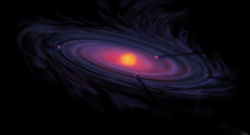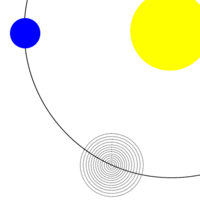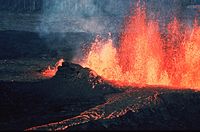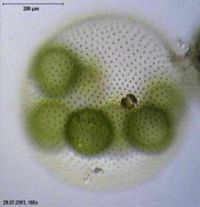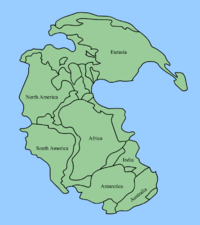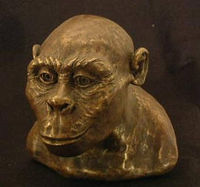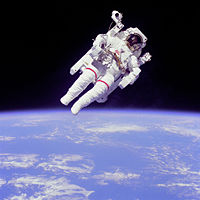History of Earth
2008/9 Schools Wikipedia Selection. Related subjects: Geology and geophysics
The history of Earth covers approximately 4.6 billion years (4,567,000,000 years), from Earth’s formation out of the solar nebula to the present. This article presents a broad overview, summarizing the leading, most current scientific theories.
Origin
The Earth formed as part of the birth of the Solar System: what eventually became the solar system initially existed as a large, rotating cloud of dust, rocks, and gas. It was composed of hydrogen and helium produced in the Big Bang, as well as heavier elements ejected by supernovas. Then, as one theory suggests, about 4.6 billion years ago a nearby star was destroyed in a supernova and the explosion sent a shock wave through the solar nebula, causing it to gain angular momentum. As the cloud began to accelerate its rotation, gravity and inertia flattened it into a protoplanetary disk oriented perpendicularly to its axis of rotation. Most of the mass concentrated in the middle and began to heat up, but small perturbations due to collisions and the angular momentum of other large debris created the means by which protoplanets began to form. The infall of material, increase in rotational speed and the crush of gravity created an enormous amount of kinetic heat at the center. Its inability to transfer that energy away through any other process at a rate capable of relieving the build-up resulted in the disk's centre heating up. Ultimately, nuclear fusion of hydrogen into helium began, and eventually, after contraction, a T Tauri star ignited to create the Sun. Meanwhile, as gravity caused matter to condense around the previously perturbed objects outside of the new sun's gravity grasp, dust particles and the rest of the protoplanetary disk began separating into rings. Successively larger fragments collided with one another and became larger objects, ultimately destined to become protoplanets. These included one collection approximately 150 million kilometers from the centre: Earth. The solar wind of the newly formed T Tauri star cleared out most of the material in the disk that had not already condensed into larger bodies.
Moon
The origin of the Moon is still uncertain, although much evidence exists for the giant impact hypothesis. Earth may not have been the only planet forming 150 million kilometers from the Sun. It is hypothesized that another collection occurred 150 million kilometers from both the Sun and the Earth, at their fourth or fifth Lagrangian point. This planet, named Theia, is thought to have been smaller than the current Earth, probably about the size and mass of Mars. Its orbit may at first have been stable, but destabilized as Earth increased its mass by the accretion of more and more material. Theia swung back and forth relative to Earth until, finally, an estimated 4.533 billion years ago, it collided at a low, oblique angle. The low speed and angle were not enough to destroy Earth, but a large portion of its crust was ejected into space. Heavier elements from Theia sank to Earth’s core, while the remaining material and ejecta condensed into a single body within a couple of weeks. Under the influence of its own gravity, this became a more spherical body: the Moon. The impact is also thought to have changed Earth’s axis to produce the large 23.5° axial tilt that is responsible for Earth’s seasons. (A simple, ideal model of the planets’ origins would have axial tilts of 0° with no recognizable seasons.) It may also have sped up Earth’s rotation and initiated the planet’s plate tectonics.
The Hadean eon
The early Earth, during the very early Hadean eon, was very different from the world known today. There were no oceans and no oxygen in the atmosphere. It was bombarded by planetoids and other material left over from the formation of the solar system. This bombardment, combined with heat from radioactive breakdown, residual heat, and heat from the pressure of contraction, caused the planet at this stage to be fully molten. During the iron catastrophe heavier elements sank to the centre while lighter ones rose to the surface producing the layered structure of the Earth and also setting up the formation of Earth's magnetic field. Earth's early atmosphere would have comprised surrounding material from the solar nebula, especially light gases such as hydrogen and helium, but the solar wind and Earth's own heat would have driven off this atmosphere.
This changed when Earth was about 40% its present radius, and gravitational attraction allowed the retention of an atmosphere which included water. Temperatures plummeted and the crust of the planet was accumulated on a solid surface, with areas melted by large impacts on the scale of decades to hundreds of years between impacts. Large impacts would have caused localized melting and partial differentiation, with some lighter elements on the surface or released to the moist atmosphere.
The surface cooled quickly, forming the solid crust within 150 million years; although new research suggests that the actual number is 100 million years based on the level of hafnium found in the geology at Jack Hills in Western Australia. From 4 to 3.8 billion years ago, Earth underwent a period of heavy asteroidal bombardment. Steam escaped from the crust while more gases were released by volcanoes, completing the second atmosphere. Additional water was imported by bolide collisions, probably from asteroids ejected from the outer asteroid belt under the influence of Jupiter's gravity. The planet cooled. Clouds formed. Rain gave rise to the oceans within 750 million years (3.8 billion years ago), but probably earlier. Recent evidence suggests the oceans may have begun forming by 4.2 billion years ago. The new atmosphere probably contained ammonia, methane, water vapor, carbon dioxide, and nitrogen, as well as smaller amounts of other gases. Any free oxygen would have been bound by hydrogen or minerals on the surface. Volcanic activity was intense and, without an ozone layer to hinder its entry, ultraviolet radiation flooded the surface.
Life
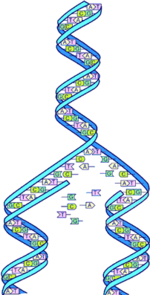
The details of the origin of life are unknown, though the broad principles have been established. Two schools of thought regarding the origin of life have been proposed. The first suggests that organic components may have arrived on Earth from space (see “ Panspermia”), while the other argues for terrestrial origins. The mechanisms by which life would initially arise are nevertheless held to be similar. If life arose on Earth, the timing of this event is highly speculative—perhaps it arose around 4 billion years ago. In the energetic chemistry of early Earth, a molecule (or even something else) gained the ability to make copies of itself–the replicator. The nature of this molecule is unknown, its function having long since been superseded by life’s current replicator, DNA. In making copies of itself, the replicator did not always perform accurately: some copies contained an “error.” If the change destroyed the copying ability of the molecule, there could be no more copies, and the line would “die out.” On the other hand, a few rare changes might make the molecule replicate faster or better: those “strains” would become more numerous and “successful.” As choice raw materials (“food”) became depleted, strains which could exploit different materials, or perhaps halt the progress of other strains and steal their resources, became more numerous.
Several different models have been proposed explaining how a replicator might have developed. Different replicators have been posited, including organic chemicals such as modern proteins, nucleic acids, phospholipids, crystals, or even quantum systems. There is currently no method of determining which of these models, if any, closely fits the origin of life on Earth. One of the older theories, and one which has been worked out in some detail, will serve as an example of how this might occur. The high energy from volcanoes, lightning, and ultraviolet radiation could help drive chemical reactions producing more complex molecules from simple compounds such as methane and ammonia. Among these were many of the relatively simple organic compounds that are the building blocks of life. As the amount of this “organic soup” increased, different molecules reacted with one another. Sometimes more complex molecules would result—perhaps clay provided a framework to collect and concentrate organic material. The presence of certain molecules could speed up a chemical reaction. All this continued for a very long time, with reactions occurring more or less at random, until by chance there arose a new molecule: the replicator. This had the bizarre property of promoting the chemical reactions which produced a copy of itself, and evolution began properly. Other theories posit a different replicator. In any case, DNA took over the function of the replicator at some point; all known life (with the exception of some viruses and prions) use DNA as their replicator, in an almost identical manner (see genetic code).
Cells
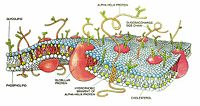
Modern life has its replicating material packaged neatly inside a cellular membrane. It is easier to understand the origin of the cell membrane than the origin of the replicator, since the phospholipid molecules that make up a cell membrane will often form a bilayer spontaneously when placed in water. Under certain conditions, many such spheres can be formed (see “ The bubble theory”). It is not known whether this process preceded or succeeded the origin of the replicator (or perhaps it was the replicator). The prevailing theory is that the replicator, perhaps RNA by this point (the RNA world hypothesis), along with its replicating apparatus and maybe other biomolecules, had already evolved. Initial protocells may have simply burst when they grew too large; the scattered contents may then have recolonized other “bubbles.” Proteins that stabilized the membrane, or that later assisted in an orderly division, would have promoted the proliferation of those cell lines. RNA is a likely candidate for an early replicator since it can both store genetic information and catalyze reactions. At some point DNA took over the genetic storage role from RNA, and proteins known as enzymes took over the catalysis role, leaving RNA to transfer information and modulate the process. There is increasing belief that these early cells may have evolved in association with underwater volcanic vents known as “ black smokers”. or even hot, deep rocks. However, it is believed that out of this multiplicity of cells, or protocells, only one survived. Current evidence suggests that the last universal common ancestor lived during the early Archean eon, perhaps roughly 3.5 billion years ago or earlier., This “LUCA” cell is the ancestor of all cells and hence all life on Earth. It was probably a prokaryote, possessing a cell membrane and probably ribosomes, but lacking a nucleus or membrane-bound organelles such as mitochondria or chloroplasts. Like all modern cells, it used DNA as its genetic code, RNA for information transfer and protein synthesis, and enzymes to catalyze reactions. Some scientists believe that instead of a single organism being the last universal common ancestor, there were populations of organisms exchanging genes in lateral gene transfer.
Photosynthesis and oxygen

It is likely that the initial cells were all heterotrophs, using surrounding organic molecules (including those from other cells) as raw material and an energy source. As the food supply diminished, a new strategy evolved in some cells. Instead of relying on the diminishing amounts of free-existing organic molecules, these cells adopted sunlight as an energy source. Estimates vary, but by about 3 billion years ago, something similar to modern photosynthesis had probably developed. This made the sun’s energy available not only to autotrophs but also to the heterotrophs that consumed them. Photosynthesis used the plentiful carbon dioxide and water as raw materials and, with the energy of sunlight, produced energy-rich organic molecules ( carbohydrates).
Moreover, oxygen was produced as a waste product of photosynthesis. At first it became bound up with limestone, iron, and other minerals. There is substantial proof of this in iron-oxide rich layers in geological strata that correspond with this time period. The oceans would have turned to a green colour while oxygen was reacting with minerals. When the reactions stopped, oxygen could finally enter the atmosphere. Though each cell only produced a minute amount of oxygen, the combined metabolism of many cells over a vast period of time transformed Earth’s atmosphere to its current state. Among the oldest examples of oxygen-producing lifeforms are fossil Stromatolites.
This, then, is Earth’s third atmosphere. Some of the oxygen was stimulated by incoming ultraviolet radiation to form ozone, which collected in a layer near the upper part of the atmosphere. The ozone layer absorbed, and still absorbs, a significant amount of the ultraviolet radiation that once had passed through the atmosphere. It allowed cells to colonize the surface of the ocean and ultimately the land: without the ozone layer, ultraviolet radiation bombarding the surface would have caused unsustainable levels of mutation in exposed cells. Besides making large amounts of energy available to life-forms and blocking ultraviolet radiation, the effects of photosynthesis had a third, major, and world-changing impact. Oxygen was toxic; probably much life on Earth died out as its levels rose (the “ Oxygen Catastrophe”). Resistant forms survived and thrived, and some developed the ability to use oxygen to enhance their metabolism and derive more energy from the same food.
Endosymbiosis and the three domains of life
Modern taxonomy classifies life into three domains. The time of the origin of these domains are speculative. The Bacteria domain probably first split off from the other forms of life (sometimes called Neomura), but this supposition is controversial. Soon after this, by 2 billion years ago, the Neomura split into the Archaea and the Eukarya. Eukaryotic cells (Eukarya) are larger and more complex than prokaryotic cells (Bacteria and Archaea), and the origin of that complexity is only now coming to light. Around this time period a bacterial cell related to today’s Rickettsia entered a larger prokaryotic cell. Perhaps the large cell attempted to ingest the smaller one but failed (maybe due to the evolution of prey defenses). Perhaps the smaller cell attempted to parasitize the larger one. In any case, the smaller cell survived inside the larger cell. Using oxygen, it was able to metabolize the larger cell’s waste products and derive more energy. Some of this surplus energy was returned to the host. The smaller cell replicated inside the larger one, and soon a stable symbiotic relationship developed. Over time the host cell acquired some of the genes of the smaller cells, and the two kinds became dependent on each other: the larger cell could not survive without the energy produced by the smaller ones, and these in turn could not survive without the raw materials provided by the larger cell. Symbiosis developed between the larger cell and the population of smaller cells inside it to the extent that they are considered to have become a single organism, the smaller cells being classified as organelles called mitochondria. A similar event took place with photosynthetic cyanobacteria entering larger heterotrophic cells and becoming chloroplasts., Probably as a result of these changes, a line of cells capable of photosynthesis split off from the other eukaryotes some time before one billion years ago. There were probably several such inclusion events, as the figure at left suggests. Besides the well-established endosymbiotic theory of the cellular origin of mitochondria and chloroplasts, it has been suggested that cells gave rise to peroxisomes, spirochetes gave rise to cilia and flagella, and that perhaps a DNA virus gave rise to the cell nucleus,, though none of these theories are generally accepted. During this period, the supercontinent Columbia is believed to have existed, probably from around 1.8 to 1.5 billion years ago; it is the oldest hypothesized supercontinent.
Multicellularity
Archaeans, bacteria, and eukaryotes continued to diversify and to become more sophisticated and better adapted to their environments. Each domain repeatedly split into multiple lineages, although little is known about the history of the archaea and bacteria. Around 1.1 billion years ago, the supercontinent Rodinia was assembling. The plant, animal, and fungi lines had all split, though they still existed as solitary cells. Some of these lived in colonies, and gradually some division of labor began to take place; for instance, cells on the periphery might have started to assume different roles from those in the interior. Although the division between a colony with specialized cells and a multicellular organism is not always clear, around 1 billion years ago, the first multicellular plants emerged, probably green algae. Possibly by around 900 million years ago, true multicellularity had also evolved in animals. At first it probably somewhat resembled that of today’s sponges, where all cells were totipotent and a disrupted organism could reassemble itself. As the division of labor became more complete in all lines of multicellular organisms, cells became more specialized and more dependent on each other; isolated cells would die. Many scientists believe that a very severe ice age began around 770 million years ago, so severe that the surface of all the oceans completely froze (Snowball Earth). Eventually, after 20 million years, enough carbon dioxide escaped through volcanic outgassing; the resulting greenhouse effect raised global temperatures. By around the same time, 750 million years ago, Rodinia began to break up.
Colonization of land
![For most of Earth’s history, there were no multicellular organisms on land. Parts of the surface may have vaguely resembled this view of Mars, one of Earth’s neighboring planets.[citation needed]](../../images/449/44952.jpg)
Oxygen accumulation from photosynthesis resulted in the formation of an ozone layer that absorbed much of Sun’s ultraviolet radiation, meaning unicellular organisms that reached land were less likely to die, and prokaryotes began to multiply and become better adapted to survival out of the water. Prokaryotes had likely colonized the land as early as 2.6 billion years ago even before the origin of the eukaryotes. For a long time, the land remained barren of multicellular organisms. The supercontinent Pannotia formed around 600 million years ago and then broke apart a short 50 million years later. Fish, the earliest vertebrates, evolved in the oceans around 530 million years ago. A major extinction event occurred near the end of the Cambrian period, which ended 488 million years ago.
Several hundred million years ago, plants (probably resembling algae) and fungi started growing at the edges of the water, and then out of it. The oldest fossils of land fungi and plants date to 480–460 million years ago, though molecular evidence suggests the fungi may have colonized the land as early as 1000 million years ago and the plants 700 million years ago. Initially remaining close to the water’s edge, mutations and variations resulted in further colonization of this new environment. The timing of the first animals to leave the oceans is not precisely known: the oldest clear evidence is of arthropods on land around 450 million years ago, perhaps thriving and becoming better adapted due to the vast food source provided by the terrestrial plants. There is also some unconfirmed evidence that arthropods may have appeared on land as early as 530 million years ago. At the end of the Ordovician period, 440 million years ago, additional extinction events occurred, perhaps due to a concurrent ice age. Around 380 to 375 million years ago, the first tetrapods evolved from fish. It is thought that perhaps fins evolved to become limbs which allowed the first tetrapods to lift their heads out of the water to breathe air. This would let them survive in oxygen-poor water or pursue small prey in shallow water. They may have later ventured on land for brief periods. Eventually, some of them became so well adapted to terrestrial life that they spent their adult lives on land, although they hatched in the water and returned to lay their eggs. This was the origin of the amphibians. About 365 million years ago, another period of extinction occurred, perhaps as a result of global cooling. Plants evolved seeds, which dramatically accelerated their spread on land, around this time (by approximately 360 million years ago).,
Some 20 million years later (340 million years ago), the amniotic egg evolved, which could be laid on land, giving a survival advantage to tetrapod embryos. This resulted in the divergence of amniotes from amphibians. Another 30 million years (310 million years ago) saw the divergence of the synapsids (including mammals) from the sauropsids (including birds and non-avian, non-mammalian reptiles). Other groups of organisms continued to evolve and lines diverged—in fish, insects, bacteria, and so on—but less is known of the details. 300 million years ago, the most recent hypothesized supercontinent formed, called Pangaea. The most severe extinction event to date took place 250 million years ago, at the boundary of the Permian and Triassic periods; 95% of life on Earth died out, possibly due to the Siberian Traps volcanic event. The discovery of the Wilkes Land crater in Antarctica may suggest a connection with the Permian-Triassic extinction, but the age of that crater is not known. But life persevered, and around 230 million years ago , dinosaurs split off from their reptilian ancestors. An extinction event between the Triassic and Jurassic periods 200 million years ago spared many of the dinosaurs, and they soon became dominant among the vertebrates. Though some of the mammalian lines began to separate during this period, existing mammals were probably all small animals resembling shrews. By 180 million years ago, Pangaea broke up into Laurasia and Gondwana. The boundary between avian and non-avian dinosaurs is not clear, but Archaeopteryx, traditionally considered one of the first birds, lived around 150 million years ago. The earliest evidence for the angiosperms evolving flowers is during the Cretaceous period, some 20 million years later (132 million years ago) Competition with birds drove many pterosaurs to extinction, and the dinosaurs were probably already in decline for various reasons when, 65 million years ago, a 10-kilometer meteorite likely struck Earth just off the Yucatán Peninsula, ejecting vast quantities of particulate matter and vapor into the air that occluded sunlight, inhibiting photosynthesis. Most large animals, including the non-avian dinosaurs, became extinct. marking the end of the Cretaceous period and Mesozoic era. Thereafter, in the Paleocene epoch, mammals rapidly diversified, grew larger, and became the dominant vertebrates. Perhaps a couple of million years later (around 63 million years ago), the last common ancestor of primates lived. By the late Eocene epoch, 34 million years ago, some terrestrial mammals had returned to the oceans to become animals such as Basilosaurus which later gave rise to dolphins and whales.
Humanity
A small African ape living around six million years ago was the last animal whose descendants would include both modern humans and their closest relatives, the bonobos, and chimpanzees. Only two branches of its family tree have surviving descendants. Very soon after the split, for reasons that are still debated, apes in one branch developed the ability to walk upright. Brain size increased rapidly, and by 2 million years ago, the very first animals classified in the genus Homo had appeared. Of course, the line between different species or even genera is rather arbitrary as organisms continuously change over generations. Around the same time, the other branch split into the ancestors of the common chimpanzee and the ancestors of the bonobo as evolution continued simultaneously in all life forms. The ability to control fire likely began in Homo erectus (or Homo ergaster), probably at least 790,000 years ago but perhaps as early as 1.5 million years ago. In addition it has sometimes suggested that the use and discovery of controlled fire may even predate Homo erectus fire was possibly used by the early Lower Paleolithic (Oldowan) hominid Homo habilis and/or by robust australopithecines such as Paranthropus However it is more difficult to establish the origin of language; it is unclear whether Homo erectus could speak or if that capability had not begun until Homo sapiens. As brain size increased, babies were born sooner, before their heads grew too large to pass through the pelvis. As a result, they exhibited more plasticity, and thus possessed an increased capacity to learn and required a longer period of dependence. Social skills became more complex, language became more advanced, and tools became more elaborate. This contributed to further cooperation and brain development. Anatomically modern humans — Homo sapiens — are believed to have originated somewhere around 200,000 years ago or earlier in Africa; the oldest fossils date back to around 160,000 years ago. The first humans to show evidence of spirituality are the Neanderthals (usually classified as a separate species with no surviving descendants); they buried their dead, often apparently with food or tools. However, evidence of more sophisticated beliefs, such as the early Cro-Magnon cave paintings (probably with magical or religious significance) did not appear until some 32,000 years ago. Cro-Magnons also left behind stone figurines such as Venus of Willendorf, probably also signifying religious belief. By 11,000 years ago, Homo sapiens had reached the southern tip of South America, the last of the uninhabited continents. Tool use and language continued to improve; interpersonal relationships became more complex.
Civilization

Throughout more than 90% of its history, Homo sapiens lived in small bands as nomadic hunter-gatherers. As language became more complex, the ability to remember and transmit information resulted in a new sort of replicator: the meme. Ideas could be rapidly exchanged and passed down the generations. Cultural evolution quickly outpaced biological evolution, and history proper began. Somewhere between 8500 and 7000 BC, humans in the Fertile Crescent in Middle East began the systematic husbandry of plants and animals: agriculture. This spread to neighboring regions, and also developed independently elsewhere, until most Homo sapiens lived sedentary lives in permanent settlements as farmers. Not all societies abandoned nomadism, especially those in isolated areas of the globe poor in domesticable plant species, such as Australia. However, among those civilizations that did adopt agriculture, the relative security and increased productivity provided by farming allowed the population to expand. Agriculture had a major impact; humans began to affect the environment as never before. Surplus food allowed a priestly or governing class to arise, followed by increasing division of labor. This led to Earth’s first civilization at Sumer in the Middle East, between 4000 and 3000 BC. Additional civilizations quickly arose in ancient Egypt, at the Indus River valley and in China.
Starting around 3000 BC, Hinduism, one of the oldest religions still practiced today, began to take form. Others soon followed. The invention of writing enabled complex societies to arise: record-keeping and libraries served as a storehouse of knowledge and increased the cultural transmission of information. Humans no longer had to spend all their time working for survival—curiosity and education drove the pursuit of knowledge and wisdom. Various disciplines, including science (in a primitive form), arose. New civilizations sprang up, traded with one another, and engaged in war for territory and resources: empires began to form. By around 500 BC, there were empires in the Middle East, Iran, India, China, and Greece, approximately on equal footing; at times one empire expanded, only to decline or be driven back later.
In the fourteenth century, the Renaissance began in Italy with advances in religion, art, and science. Starting around 1500, European civilization began to undergo changes leading to the scientific and industrial revolutions: that continent began to exert political and cultural dominance over human societies around the planet. From 1914 to 1918 and 1939 to 1945, nations around the world were embroiled in world wars. Established following World War I, the League of Nations was a first step in establishing international institutions to resolve disputes peacefully; after its failure to prevent World War II and the subsequent end of the conflict it was replaced by the United Nations. In 1992, several European nations joined together in the European Union. As transportation and communication improved, the economies and political affairs of nations around the world have become increasingly intertwined. This globalization has often produced discord, although increased collaboration has resulted as well.
Recent events
Change has continued at a rapid pace from the mid- 1940s to today. Technological developments include nuclear weapons, computers, genetic engineering, and nanotechnology. Economic globalization spurred by advances in communication and transportation technology has influenced everyday life in many parts of the world. Cultural and institutional forms such as democracy, capitalism, and environmentalism have increased influence. Major concerns and problems such as disease, war, poverty, violent radicalism, and more recently, global warming have risen as the world population increases.
In 1957, the Soviet Union launched the first artificial satellite into orbit and, soon afterward, Yuri Gagarin became the first human in space. Neil Armstrong, an American, was the first to set foot on another astronomical object, the Earth's Moon. Unmanned probes have been sent to all the major planets in the solar system, with some (such as Voyager) having left the solar system. The Soviet Union and the United States of America were the primary early leaders in space exploration in the 20th Century. Five space agencies, representing over fifteen countries, have worked together to build the International Space Station. Aboard it, there has been a continuous human presence in space since 2000.

